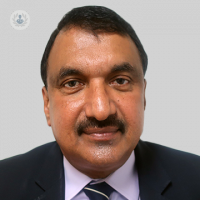How they repair hernia surgical options available
Escrito por:Traditionally, hernias were always repaired by open surgery, however recently, keyhole (or laparoscopy) repair has become increasingly popular, and the use of new techniques allows for less pain and much quicker recovery for patients.
Mr Sabu Jacob, a highly regarded general and vascular surgeon in Brentwood and Essex, explains to us the various surgical procedures available to treat a hernia.

What types of surgery are available?
There are two types of surgery to repair a hernia: open surgery and laparoscopic surgery.
Both procedures use the tension-free method which uses a synthetic polypropylene mesh to repair the tissue in the abdominal wall. This mesh is then in your body for the rest of your life and is made from a non-absorbable material. This mesh can be fitted using the following two methods:
- Open surgery
The open surgery technique is carried out by an incision in the groin area and performed under a local or general anaesthetic. This method has a longer recovery time and is more painful due to the incision in the groin.
- Laparoscopic (keyhole repair)
Laparoscopic, also known as keyhole repair, is carried out using three small incisions in the abdomen and uses a small camera to allow the surgeon to see the abdomen on a screen. It can only be done under a general anaesthetic. This method avoids the need for a groin incision, and therefore, the recovery period is quicker and there are less pain and scarring in comparison to the traditional open surgery method.
Your surgeon may decide on one of the following types of keyhole repair:
- Transabdominal preperitoneal (TAPP) - Instruments are inserted through the muscle wall of your abdomen and through the lining covering your organs, known as the peritoneal. A flap of the peritoneal is then pulled over the hernia. A piece of mesh is glued or stapled to the weak area in your abdomen wall in order to strengthen it.
- Totally extraperitoneal (TEP) - This is the newest keyhole method and repairs the hernia without entering the peritoneal cavity. Stitches are then used to seal the skin after the repair is done.
Which is more effective?
Both open and keyhole repair are safe and work very well. Although, keyhole repair does have an advantage over the open method, as it causes less pain and less muscle damage so the recovery time is shorter. Sometimes, keyhole repair can carry a higher risk of the surgeon accidentally damaging the bowel during the procedure, but this is very rare.
The risk of a hernia returning is the same with both and you should discuss your options with a surgeon before.
What exactly is a tension-free mesh hernia repair?
For a long time, surgeons used to repair a hernia by pushing the tissue back into its correct position and stitching it together - as it was the only option available. It puts tension on either side of the hernia to close it. Nowadays, surgeons are moving fast towards procedures such as tension-free mesh repair.
The tension-free mesh repair uses a mesh in order to not pull the muscles and ligaments together - hence the name ‘tension-free’. It involves inserting a mesh over the weakened abdominal wall and allowing the body tissue to grow through the mesh to form a strong and permanent repair.
The advantages of using a tension-free mesh repair are that there is much less pain after, the hernia very rarely comes back and people who undergo this surgery normally return to an active lifestyle almost immediately after the operation.
If you are worried you have a hernia and would like to book an appointment with Mr Sabu Jacob, visit his profile and get in contact with him.


